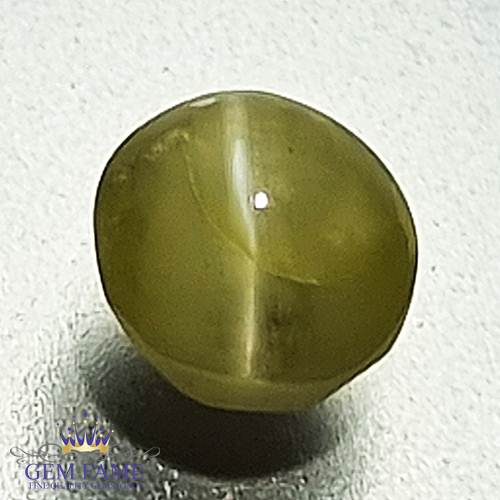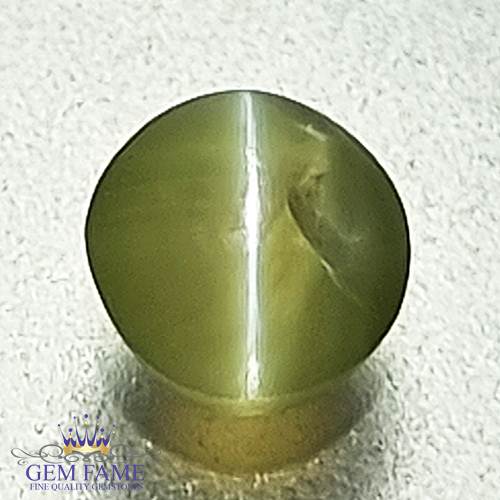Description
Chrysoberyl Cat’s Eye Stone 1.72ct
Description
This Chrysoberyl Cat’s Eye is Natural Gemstone That is Greenish Yellow Colour, it’s Originates from India and its Exact Weight is 1.72ct. The Measurements are 6.20×4.52mm. The Shape and Cut of This Stone Round Cabochon. It’s Graded Translucent and Clarity is Good. This 1.72ct Greenish Yellow Natural Chrysoberyl Cat’s Eye Gem is available for Ready to Ship anywhere in The World. You Can also Select Certification and Shipment Method as Optional.
Details
| Summary No | AK17995 |
| Species | Natural Chrysoberyl Cat’s Eye |
| Weight | 1.72ct |
| Shape/cut | Round Cabochon |
| Dimension | 6.20×4.52mm |
| Colour |
Greenish Yellow |
| Clarity | Good |
| Transparency | Translucent |
| Origin | India |
| Treatment | None |
Chrysoberyl Cat’s Eye Stone 1.72ct
Properties Of Chrysoberyl Cat’s Eye Stone
Chemical Composition: BeAl2O4 Beryllium Aluminum Oxide
Hardness: 8.5
Specific Gravity (Density): 3.75
Refractive Index: 1.746 – 1.756
About: Chrysoberyl Cat’s Eye stone
Chrysoberyl Cat’s Eye show fine parallel inclusions produce a silver white line, which appears as moving light-ray in a cabochon cut stone.The name Chrysoberyl cats eye derived from this effect, which reminds one of the pupils of a cat.The short term cats-eye always refers to Chrysoberyl, all other cats-eye must be designated by an additional name. There are deposits in Srilanka and Brazil as well as in China, India, and Zimbabwe.
Chrysoberyl is a beautiful gem and well suited for jewellery use. The combination of high hardness (8.5) and indistinct cleavage make it very durable. Although its dispersion is low, it is a very bright and colourful gem. Cat’s eye Chrysoberyl is also available. Other gems such as diopside and apatite may be called cat’s eyes, but Chrysoberyl was the original cat’s eye gem. It is the finest cat;ss eye of gems. The silky fibres are so fine that a microscope is needed to see the individual fibres. This creates a very sharp cat’s eye effect.
Chrysoberyl is not very well known in the gem world. It is somewhat overshadowed by one of its more famous varieties, Alexandrite. Alexandrite is the best known and most valuable variety of Chrysoberyl. The quality of Alexandrites colour change effect is what accounts for its desirability and value. It can change from shades of green or blue-green in daylight to shades of mauve, violet, purple or even red in incandescent light. Alexandrite is also available as a cat’s eye gem.
Occurrences of Chrysoberyl are widespread, however, fine crystals are uncommon. Notable localities include: from many places in Brazil, with exceptional crystals from Tancredo, Itagua¸cu, and Colatina, Espirito Santo; from Faria Lemos, Santa Luzia de Carangola, and Americana, Tefilo Otoni, Minas Gerais; at Campo Formoso, Teixeira de Freitas, and Cachoeira, Bahia. From Markov, Å umperk, Moravia, Czech Republic. At the Izumrudnye mines, Tokovaya River, near Yekaterinburg (Sverdlovsk), and Mursinka, Ural Mountains, Russia. From Miakanjovato, near Lake Alaotra, northeast of Ambatosoratra, Madagascar. Near Masvingo (Ft. Victoria), Zimbabwe. Abundant in gem gravel placers in the Ratnapura district, Sri Lanka. In the USA, from near Golden, Jefferson County, Colorado; in Maine, at Topsham, Sagadahoc County, from Paris, Norway, and Hartford, Oxford County, and elsewhere




























